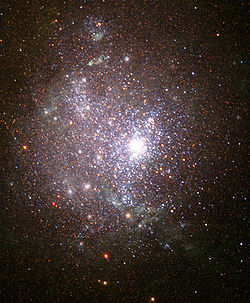
Blue compact dwarf galaxy
Encyclopedia

Astronomy
Astronomy is a natural science that deals with the study of celestial objects and phenomena that originate outside the atmosphere of Earth...
, a blue compact dwarf galaxy (BCD galaxy) is a small galaxy
Galaxy
A galaxy is a massive, gravitationally bound system that consists of stars and stellar remnants, an interstellar medium of gas and dust, and an important but poorly understood component tentatively dubbed dark matter. The word galaxy is derived from the Greek galaxias , literally "milky", a...
which contains large clusters of young, hot, massive star
Star
A star is a massive, luminous sphere of plasma held together by gravity. At the end of its lifetime, a star can also contain a proportion of degenerate matter. The nearest star to Earth is the Sun, which is the source of most of the energy on Earth...
s. These stars cause the galaxy to appear blue
Blue
Blue is a colour, the perception of which is evoked by light having a spectrum dominated by energy with a wavelength of roughly 440–490 nm. It is considered one of the additive primary colours. On the HSV Colour Wheel, the complement of blue is yellow; that is, a colour corresponding to an equal...
in color. Since they exist mostly in clusters, blue compact dwarf galaxies don't have an exact uniform shape. They consume gas intensely, which causes their stars to become very violent when they are forming.
Blue compact dwarf galaxies cool in the process of forming new stars. Their stars are all formed at different time periods, so the galaxies have time to cool and to build up matter to form new stars.
The galaxies aren't blue throughout - they actually have a lot of stars of different colors. But throughout them there are a lot of star-forming regions in which the most massive and brightest stars are blue. Since these stars greatly outshine their neighbors, the combined light from these galaxies appears blue from far away.
As time passes, blue compact dwarf galaxies change shape due to star formation. Below are examples of some formations they take as new stars are being created:
Nearby examples include NGC 1705
NGC 1705
NGC 1705 is a peculiar lenticular galaxy in the constellation Pictor. It is estimated to be approximately 17 million light-years from the Earth. It is a member of the Dorado Group.-External links:*...
, NGC 2915
NGC 2915
NGC 2915 is a blue dwarf galaxy located 12 million light-years away, right on the edge of the Local Group. It is remarkable in that the optical galaxy corresponds to the core of a much larger spiral galaxy traced by radio observation of neutral hydrogen....
and NGC 3353.

